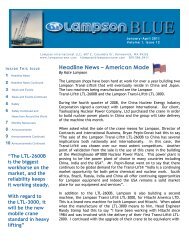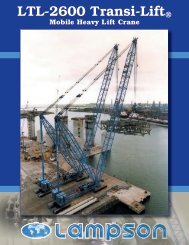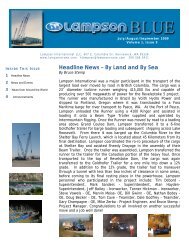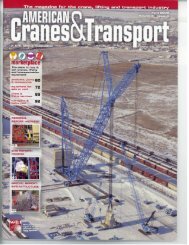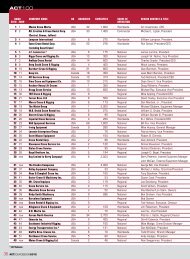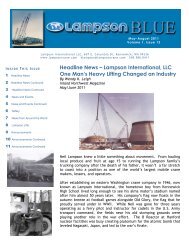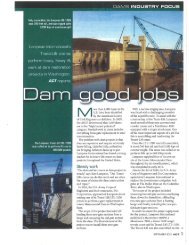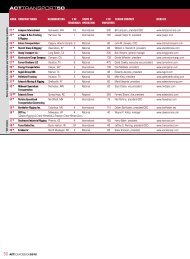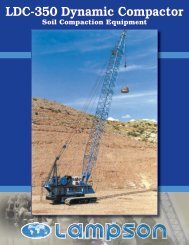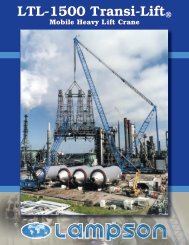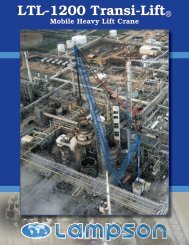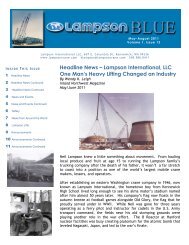Crane Hotline Magazine - Lampson International, LLC
Crane Hotline Magazine - Lampson International, LLC
Crane Hotline Magazine - Lampson International, LLC
You also want an ePaper? Increase the reach of your titles
YUMPU automatically turns print PDFs into web optimized ePapers that Google loves.
Product FocusHeavy-Lift <strong>Crane</strong> NewsDeep South, Baton Rouge, La., manufactures the Versa<strong>Crane</strong> line of megaringer cranes, from 750 to 2,500 tons. Standing taller than 600 feet, thecrane was designed as compactly as possible to work in congested spaces,and to travel freely and economically for the end user. Deep South toutsthe crane’s technological design as offering the lowest ground-bearing pressurein the industry. According to the company’s website, the 1,000-tonVersa<strong>Crane</strong> model CC-12000 was introduced in 2009.<strong>Lampson</strong> <strong>International</strong>, Kennewick, Wash., will deliver a new Transi-LiftLTL-3000 to Hitachi America Ltd., in Japan, late next year. The crane willmonopolize a large part of the <strong>Lampson</strong> manufacturing facilities in Pasco,and Kennewick, Wash., as it takes about 14 months to build. It will leavePasco on a barge bound for a West Coast port, according to Kate <strong>Lampson</strong>.Once there, it will be transferred to an ocean-going vessel headed for Japan.After it reaches the shores of Japan, it will be transported to the site ofthe Higashidori nuclear plant in some 85 truckloads. On arrival, it will take<strong>Lampson</strong> technical representatives about four weeks to assist in the crane’sassembly. “Not all cranes of this class are custom made,” says Katie Lampton.“<strong>Lampson</strong> <strong>International</strong>, however, has the unique capability to modify thestandard design to custom build certain components in order to fulfill ourcustomers’ specific requirements.”Liebherr <strong>Crane</strong>s, Inc., Newport News, Va., is in the final testing stagewith what will be its flagship crane, the LR 13000. A 3,500-ton crawlercrane, the prototype was on the test pad in Germany at press time. Thecrawler was designed for the large jobs taken on by companies specializingin planning new nuclear or power plants. “The requirements these days areto assemble—as much as possible—parts on the ground and to lift it withone lift in place,” explains Georg Diesch, president of Liebherr <strong>Crane</strong>s. “Thatway time can be saved and even the risk is minimized.”Mammoet USA South Inc., Rosharon, Texas, announced the introduction oftwo New Generation ringer cranes late last summer. Designed for the heaviestof lifts are the PTC 120 DS, with a maximum load moment of 120,000 tonmeters, and the PTC 160 DS, with 160,000 ton meters of load moment. Thesecranes feature capacity and versatility to enable their owners to respond tothe changing needs of markets and projects, including the power, petrochemical,civil and offshore industries, according to the company.Manitowoc <strong>Crane</strong>s, Manitowoc, Wis., announced this summer that it hadcompleted overload testing of its 2,535-ton Model 31000 crawler. The cranelifted 5.5 million pounds. “The lift went very smoothly, and our unique VariablePosition Counterweight worked perfectly,” says Larry Weyers, executivevice president of the Americas region. Boom lengths on the 31000 will rangefrom 180 feet to 344 feet, and various fixed and luffing jib set-ups will beavailable for the heavy-lift crawler, which has already attracted interest.The first unit has been sold, and will be delivered in the late third quarterof 2011, reports Jerry Maloney, global product director, lattice boom crawlercranes. “The owner of the crane is in North America,” says Maloney. “Whereit goes to work is another story.”Sarens Group, Alameda, Calif., announced in May it would be makingthe new SGC 120 available in early 2011. With a ringer configuration, theheavy-lift crane is the result of combined engineering efforts from Sarensand its newest group member, Rigging <strong>International</strong> of Alameda. Toutedas the only third-generation 120,000 ton meter crane in production, the3,500-ton machine is designed to accommodate the requirements of refinery,petrochemical, offshore platform and nuclear power plant designs. “Sarens isworking on the largest crane in the world right now,” reports Stephen Kenneywith Rigging <strong>International</strong>.Terex Corp., Westport, Conn., introduced the 1,700-ton Terex DemagCC 9800 early in 2009, citing worldwide demand for heavy-lift machines.Designed with multiple configurations, the crane is an adaptation of the originalTerex Demag CC 8800-1, and uses the same basic machine components asthe 3,500-ton capacity Terex Demag CC 8800-1 Twin. Terex engineered in awider boom system, with components up to 13 feet, for a higher maximumload moment rating of 27,000 ton meters, when configured with 881 tons ofSuperlift counterweight at a 98-foot radius. Maximum boom and jib lengthfor the Terex Demag CC 9800 are 511 feet and 393 feet, respectively. Maximumluffing fly jib SWSL combination is 354 + 393 feet, resulting in a tophook height of 754 feet. The factory also makes available a configuration forthe erection of wind turbines of more than 6 MW capacity. Incorporating a433-foot main boom, plus a 59-foot extension, it allows the crane to lift 413tons to a hook height of 482 feet.The new 2,535-tonmodel 31000 crawlercrane from Manitowocfeatures thecompany’s patentedVariable PositionCounterweight.gives us some capability of always maintainingground contact,” adds Wood.Inheriting good traitsSome in the industry describe megaor heavy-lift cranes as starting around750 tons capacity, going up from there toseveral thousand tons. Each major playerin the mega-crane manufacturing gameclaims a distinctive engineering feat thatsets their machine apart in a highly competitivemarket. Some companies, such asDeep South, <strong>Lampson</strong>, and Sarens Group,focus solely on heavy-lift machines, whilecompanies such as Liebherr and Manitowocproduce machines that run the gamutfrom 30 to 3,000 tons.Engineers for these multi-class manufacturerssay the innovations designed intothe mega-cranes can actually translateinto features and benefits for their moremoderately-sized counterparts. Liebherr’sfocus is on versatility at any capacity. “AllLiebherr mobile and crawler cranes aredesigned and built with our customersin mind, but with the flexibility to serveseveral job applications rather than for aspecial project or a particular customer,”explains Diesch.“However,” he adds, “with almost endlessvariations of booms combined withderrick systems and counterweight combinations,every customer can ‘customize’his crane in accordance with his mostimportant applications. This is also importantfor re-marketing the crane.”Manitowoc, on the other hand, believesits VPC system will create more efficientset-up in smaller cranes. Jerry Maloney,global product director, lattice-boom26 CRANE HOT LINE NOVEMBER 2010 • cranehotline.com
HEAVY-LIFT CRANEScrawler cranes, believes the company will,in fact, try to incorporate the concept intolower-capacity crawlers. “We think it’s a realbreakthrough in crane design, and one thatwould serve cranes at both ends of the range,”he says, adding that “with the VPC and fourcrawler tracks on trunnions, the ground bearingpressure is equal to or less than a 300-tonsize machine. That helps a lot in site prep.”More where that came fromAsked if these massive new cranes are oneoffs,the manufacturers we spoke with said itdepends on market demand. Kate <strong>Lampson</strong>believes if the call comes in, the company willbegin building another model 3000. “We rentthe Transi-Lift, along with our engineeringstaff as well as our own operators and mechanicswho are running and flagging the crane. Ifa nuclear power company says ‘We’ve seenone, and, we’d like you to build one becausewe’re going to buy it,’ then we’ll manufactureone for them.”Manitowoc is also taking a wait-and-seeattitude, but Wood says there’s a possibilityother 31000s will come to market. “We’retrying to forecast the next machine; trying toThe transporters on the Transi-LiftLTL-3000 from <strong>Lampson</strong> <strong>International</strong>were designed as independent trackdrivenmachines positioned at the baseof the crane, allowing it to maneuverfront to back, side to side, and in crabconfigurations. The 3,000-ton cranewas being built this summer.gauge significant interest,” he explains. “Withall the power work going on around the world,there’s no reason for us to believe further unitswon’t be produced.”And will these manufacturers go even bigger?Well, they say, it depends—on marketdemand and machine transportability. Manitowocbelieves its engineers are limited onlyby mobility. “There’s a point at which movingthe equipment becomes a pretty difficulttask,” says Wood. “The bigger this crane gets,the harder it’ll be to move,” That, he says, willstop the capacity caravan.<strong>Lampson</strong> says it boils down to that call:“Right now, this is the largest-capacity crawlercrane we have. If there’s a need for largecapacitycranes within the industry, cranemanufacturers will probably make them. Butit has to make sense. If we get another orderfrom a client for a 3000, we will build it.”See us atBooth #215Gold Lotcranehotline.com • NOVEMBER 2010CRANE HOT LINE27



